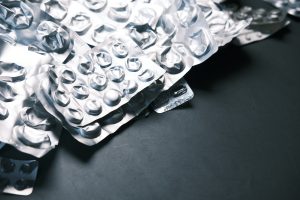
New chemical recycling process allows recycling of medicine strips
Canadian Plastics
Packaging Recycling Research & DevelopmentEngineering students from the National University of Singapore have developed a chemical recycling method to separate plastic from aluminum and salvage both components.

Photo Credit: Adobe Stock/Towfiqu
Plastics recycling is on everyone’s mind these days, but the problem is that plastic is one of the most difficult materials to recycle. There are many reasons why – most types of plastic look the same, for example, are generally hard to distinguish from one another with the human eye and hand, and most different plastic types are not compatible with each other. And there’s also the issue of separating them from other materials in the post-consumer state. A case in point is plastic and aluminum: because they’re heat-sealed together with a type of glue, it’s difficult to separate the plastic from aluminum in the multi-layer packaging of medicine strips – commonly called blister packaging – so they’re usually discarded as general waste and cannot be recycled.
To avoid having to throw them in the incinerators, a group of engineering students from the National University of Singapore (NUS) has developed a chemical recycling method to separate plastic from aluminum and salvage both components. Both materials can then be sent to recycling companies.
The student initiative, called the Green Doctors Program, was created last August when a pharmacist from the National University Hospital (NUH) approached the NUS department of Civil and Environmental Engineering to find a way to reduce medical waste.
Every month, commonly prescribed medicines at NUH account for about 200,000 medicine strips being used up. Overall, about five million strips are thrown away every month in Singapore, said NUS civil and environmental engineering student Sophia Ding, founder of the Green Doctors Program.
After three months of research, the Green Doctors Program concocted a recipe to dissolve the adhesive layer between the plastic and aluminum earlier this year, so that the materials can be separated. The team, which includes about 10 chemical, environmental, and mechanical engineering students, has been testing and working to optimize their solution using medicine strips provided by NUH.
“There were only two research papers on recycling medical blister packaging. So, it was very difficult for us to come up with the methodology ourselves because we had to infer and go into the roots of the materials,” Ding said. “And we had to think about the technology that goes behind heat-sealing, and how to separate the layers without doing much harm to the original materials.”
If all medicine strips in Singapore were to be recycled, 16 tons of plastic and 2 tons of aluminum could be saved each month, she added.
According to the World Health Organization, about 85 per cent of all waste from healthcare activities is non-hazardous, general waste. The remaining 15 per cent is biohazardous waste that is infectious, toxic or radioactive, and must be collected and disposed of safely and carefully to prevent cross-contamination and other public health risks.
The Green Doctors Program also plans to look into how other types of hard-to-recycle medical waste such as IV bags can be recycled.
